Best cycling shoes: Our pick of the best shoes for road cyclists, tested and reviewed
The best road cycling shoes are the foundation of every great ride, these are our favourites for performance, comfort and style
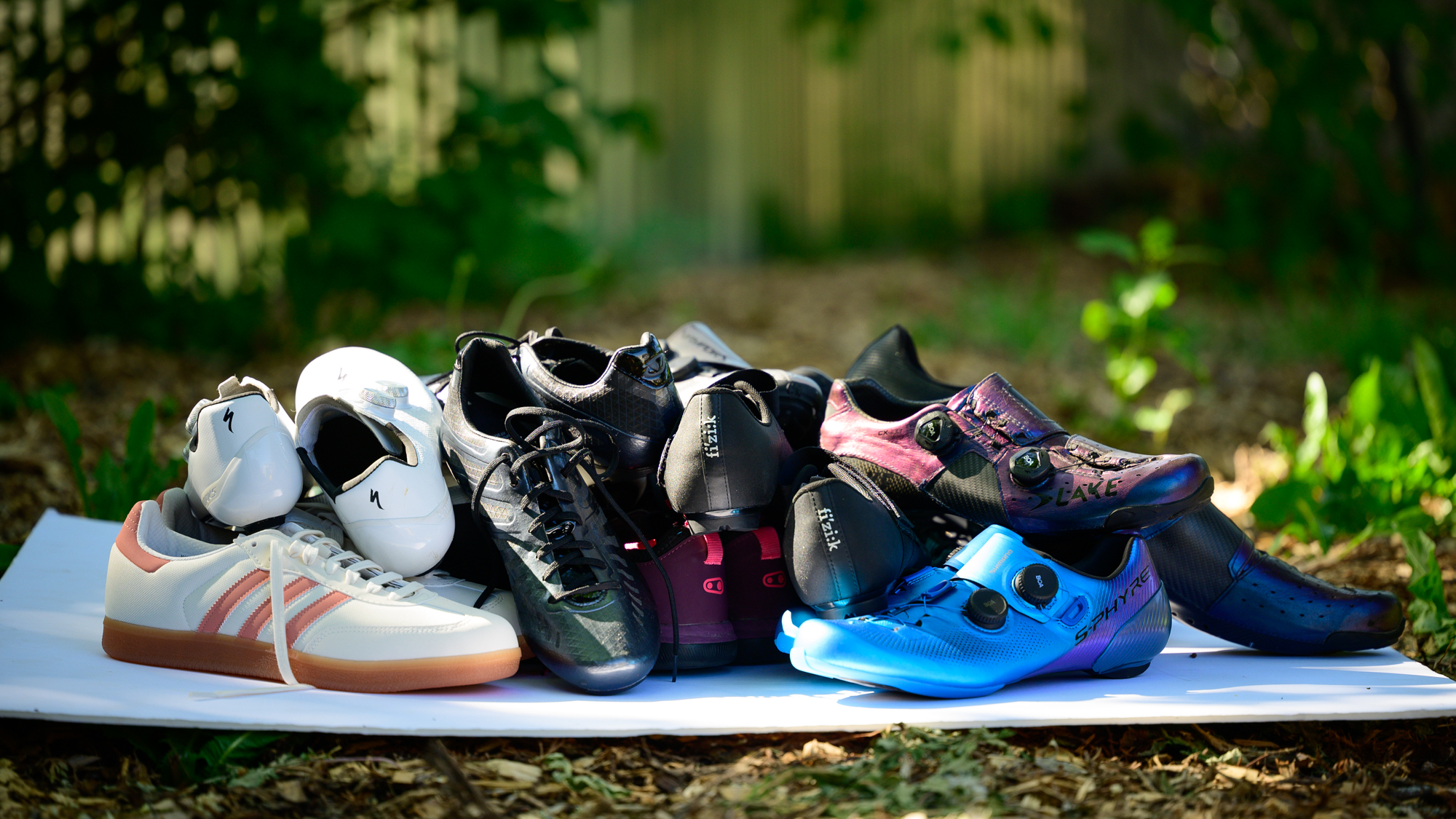
The best road cycling shoes offer foot comfort and support for efficient power delivery for miles of riding. They look the part too.
Road cycling shoes typically include a three-bolt cleat interface to mesh with the best road bike pedals, which are usually single-sided. The best gravel bike shoes have recessed two-bolt cleats and work with gravel bike pedals, which are usually double-sided for easier clipping in.
Since cycling shoes are so fundamental to efficiency and performance, they're a big focus of our reviews here at Cyclingnews, and we've tested an extensive range, riding many miles to bring you our in-depth reviews and help you to choose the best road cycling shoes for you.
Our top pick is the Specialized S-Works Torch, but we have highlighted many more shoes that we think are well worth considering. Towards the bottom of this post, we have advice on how to choose the best road cycling shoes for your needs and answer frequently asked questions that many cyclists have about the best cycling shoes.
Quick list: Best cycling shoes

Specialized's Torch delivers incredible all-round levels of comfort, support and performance. While they may not necessarily excel in one area, the overall performance is hard to beat.

Fizik avoids the expense of BOA dials and instead uses the same retention system found on some of the brand's top-shelf shoes. Comfortable and capable, these shoes punch above their price category.

Finding an off-road shoe with a carbon sole stiff enough for long days and mixed surfaces while also having enough protection to handle running up a rocky ascent is like finding a unicorn. The Rapha Explore Powerweave is one of those unicorns.

The Giro Empire shoes offer a classic lace-up aesthetic with low weight and great ventilation to boot.
Read more below

The Bont Vaypor is custom mouldable with one of the stiffest outsoles on the market. The fact that you can mould these in your own home, plus options for wider fit models, semi-custom, or full custom options, should cover every foot shape.

Lake's shoes come in multiple widths and are generally wider than many cycling shoes, so they're a good option for wider feet.
Last updated on 14th of November 2025 Recently reviewed shoes added, discontinued shoes removed, How To Choose section has been reformatted and additions to Everything You Need To Know section about shoe closure and materials.
Best cycling shoes available today
You can trust Cyclingnews
Best road cycling shoes
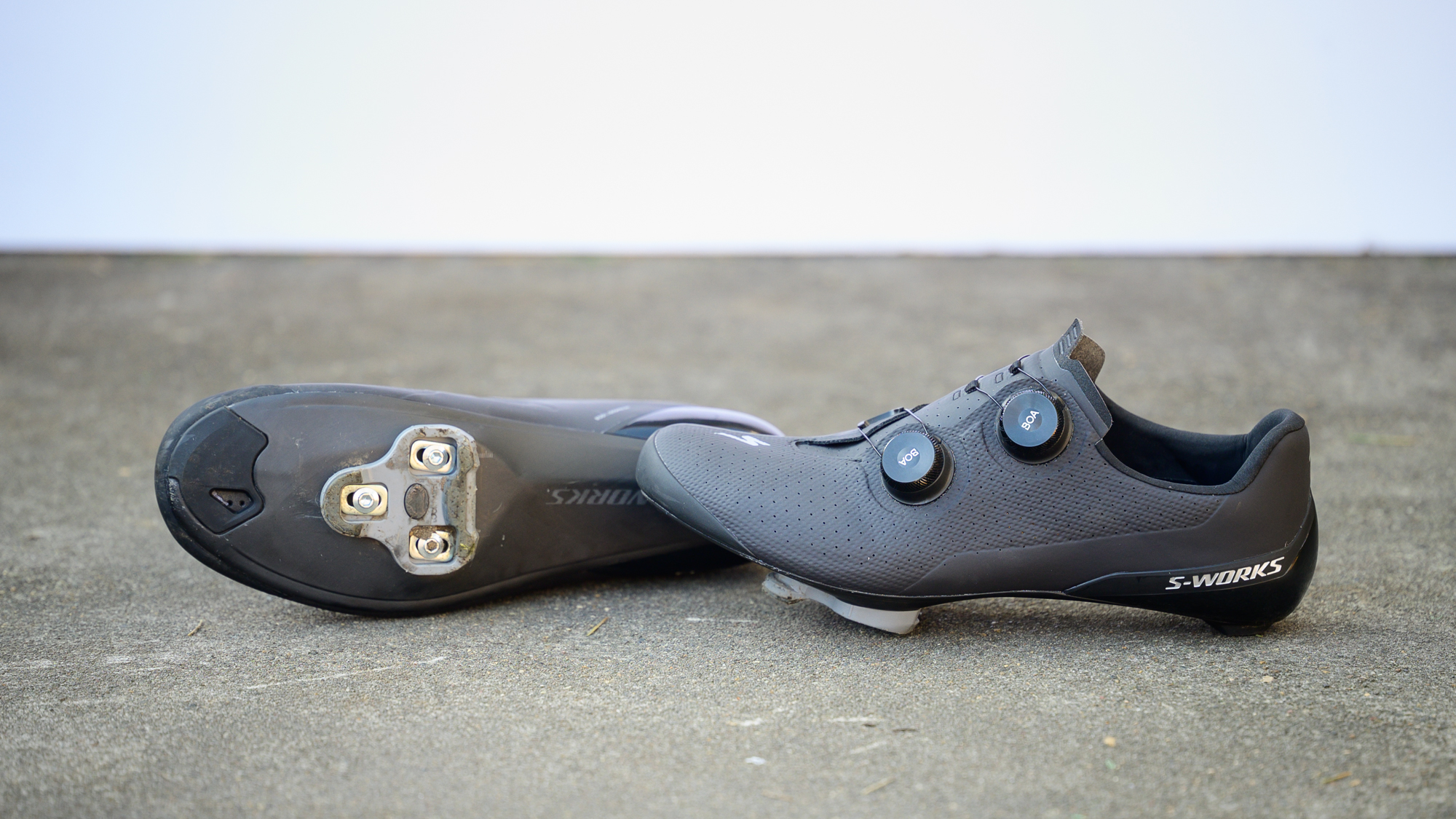
Specifications
Reasons to buy
Reasons to avoid
✅ You want a road shoe that excels at all types of riding: The S-Works Torch is the perfect blend of performance and comfort, making it a superb option no matter the ride. Standard and wide fits should cover most foot shapes and the stiff carbon sole with a well-constructed upper makes every pedal stroke count.
✅ You want a great-looking shoe: Specialized's minimal branding and simple design give the S-Works Tworch a clean aesthetic.
❌ You want an affordable shoe: Being labelled S-Works signifies this being the best road bike shoe Specialized makes and thus commands a high price. For something more affordable, Specialized offers three Torch models for mid and low budgets.
Over the years, Specialized has been shifting the shape of the shoes the brand makes. More and more the toe box is wider with more room, making comfort on a par with the best road cycling shoes. The Specialized S-Works Torch is the replacement for the S-Works 7 and measures 4mm wider at the ball than the previous generation cycling shoe.
The changes aren't just the work of intuition either. Specialized pulls from the trends seen through over 100,000-foot scans as part of the in-house RETÜL fit system. The same data also guides the particular shape of the central cut-out as well as the angle of BOA dials and the way that they sit on the shoe. It's also data you can feel when putting on the shoe.
The end result is a cycling shoe that seems to be good at everything. Short rides, endurance rides, racing, day in and day out the S-Works Torch is a shoe you can grab and know it will work. I've highlighted several shoes that are good at a particular thing. The S-Works Torch is more of an all-arounder and while some shoes are polarising, the Torch will work for almost everyone. If you want a great road cycling shoe without having to decide if a certain use case is right for you, grab the Torch.
It's also nice that the outer is so hard-wearing. Since you are likely to be wearing the S-Works Torch a lot, things like reinforced uppers, protection at the toe against toe rub, an easy-to-wipe-clean outer, and metal BOA dials are an advantage. Unfortunately, those BOA dials, while looking great and holding up well, do lack pop-to-release.
Read more details in our full Specialized S-Works Torch review.
Best budget cycling shoes
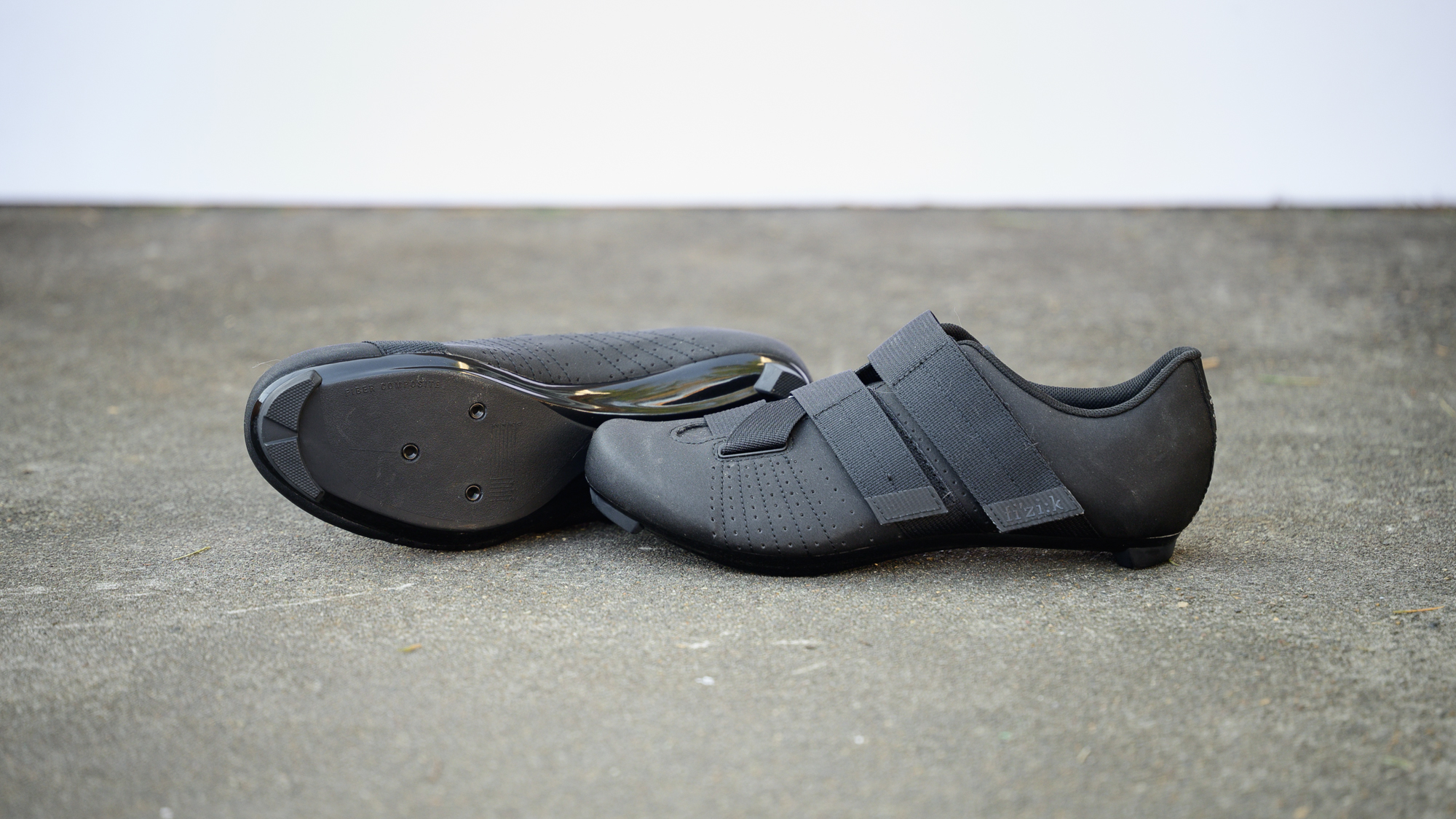
Specifications
Reasons to buy
Reasons to avoid
✅ You want an affordable road shoe: Considering the specs, the Fizik Tempo R5 Powerstrap offer excellent performance for a reasonable outlay.
✅ You want the simplicity of a velcro closure: The Powerstraps are easy to use and give a firm closure across the foot
❌ You don't want to make fine-tune fit adjustments: Velcro doesn't give the versatility of laces or the adjustability of a BOA dial when on the move.
❌ You ride in hot weather: Ventilation isn't specifically bad, however, Velcro strap coverage reduces ventilation in the uppers, and there is no sole vent.
The Fizik Tempo Powerstrap R5 is going to be somewhat controversial as an overall best-budget cycling shoe selection. BOA dials dominate the options for modern cycling shoes and many cyclists consider them a must-have. I kind of agree and yet, these shoes have none.
My reasoning has to do with price and available options. Quite simply, BOA dials cost money. BOA is a separate company and using them means licensing the technology. When it comes to budget shoes, that cost tends to put dual zone adjustments out of reach and even the single BOA dial used is often one of the lower-spec options without all the features that make BOA great. Fizik gets around this challenge by just leaving BOA dials off the design and instead using an innovative system of big straps and Velcro.
The straps that Fizik uses aren't like what you find on other brands of shoes. Instead of a stiff strap that pulls the opening above the tongue closed, Fizik connects the straps of the Tempo Powerstrap R5 to the base of the shoe. The strap material is also different and it's both strong and flexible with no pressure points. The whole system sits close to the shoe, making it fast and simple to get the fitment perfect, and if you need to pull some kind of winter cover over, there's nothing to get in the way.
Fizik frequently creates two shoes that are exactly the same, other than one will have a two-bolt cleat interface and tread and one will have a road-specific base. That’s the case with the Tempo Powerstrap R5 as well, so if you prefer walkability for your road bike, or if you need a gravel shoe, check out our review of the Fizik X4 Terra Powerstrap.
The downside, of course, is that there is no BOA dial. It's still pretty easy to adjust mid-ride if you have to, but it will never be as simple or precise as a BOA dial. The shoes are also a bit on the warm side as they lack a vent through the sole of the shoe.
Head over to our Fizik Tempo Powerstrap R5 cycling shoes review for more details..
Best cycling shoes for cleat adjustment
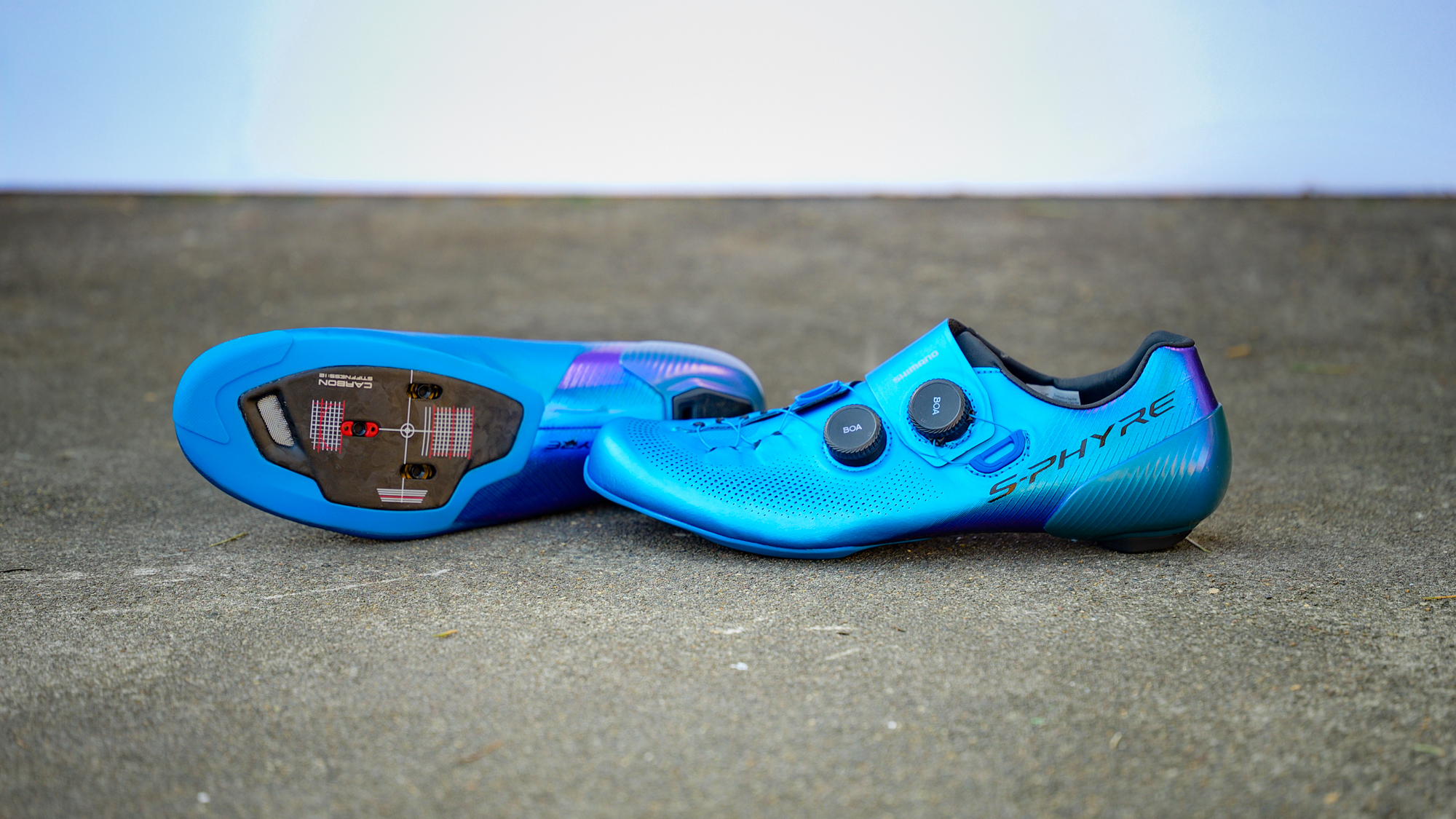
Specifications
Reasons to buy
Reasons to avoid
✅ You want lots of cleat adjustment: The long cleat adjustment slots give a lot more room for you to find your perfect cleat position.
✅ You want a precise-feeling shoe: A well-measured fit and understanding of pedalling dynamics mean the S-Phyre RC903 is a joy to spin the pedals in.
❌ You are rough with your shoes: While covering exposed carbon will stop any unsightly scratches, the micro-fibre leather used to wrap it is at risk of tearing.
Shimano and Specialized are, at least in the US, the two most common cycling shoe brands. Just about every bike shop carries both and comparisons are obvious. As you look to decide between the two, the signature difference is how Shimano handles the closure design. Instead of coming from both sides of the shoe and closing in the middle, as you'd expect from a shoe, Shimano wraps one side over the other. It's unique compared to almost everything on the market and it makes for a narrower fit throughout. This latest generation adds more vertical volume at the toe, but as soon as you start to head towards the back of the shoe, everything narrows out. It's not as narrow as Giro but more so than Specialized and that continues to the heel cup, which is even narrower than the Giro Empire.
Outside of that, the big differentiator for Shimano is how much cleat adjustment the brand builds into the sole. It might not sound like a big difference, but if you want to get your cleat way back to the centre of your foot, most brands won't do it. Shimano does, as does Fizik, but Fizik is even more narrow than Shimano. If that's your desire, Shimano will do it and you also get excellent toe rub protection, great mid-foot retention, and incredible colour options. The only downside is that the covered section of the sole definitely takes damage compared to the carbon on the outside.
You can read more details in our full Shimano S-Phyre RC903 review.
Best cycling shoes with laces
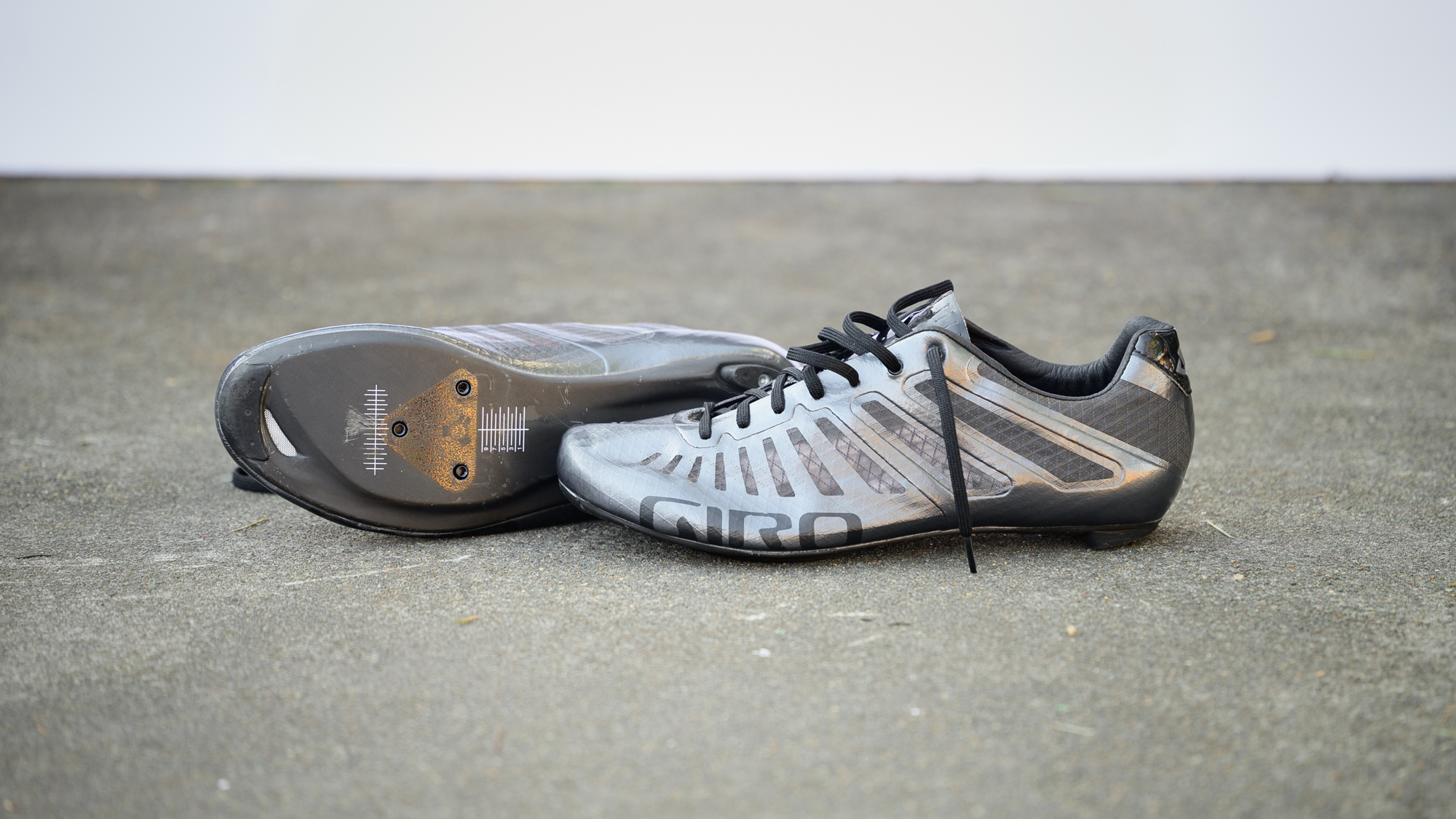
Specifications
Reasons to buy
Reasons to avoid
✅ You want a lightweight and airy shoe: The Empire SLX are one of the lightest shoes around and features ample venting across the uppers and in the sole.
✅ You want laces: Ultra supple upper and stretchy laces give the Empire SLX's make these extremely comfortable
❌ You ride in colder climates: Considering the upper is thin enough that you can see the colour of your socks, it's no surprise these aren't well-suited to cold conditions.
❌ You have wide feet: The narrow fit won't suit riders who need more volume.
The basic Giro Empire design has been around for years. The latest version is the Giro Empire SLX, but the formula is essentially unchanged. Way back then, and now, the idea is to use a seemingly simple construction to make an ultra-breathable, lightweight and most exacting shoe possible. If you want a wide shoe or an ultra-stiff sole, you will want to look elsewhere. I almost added BOA dials to that list as well but there is a slightly heavier version with BOA dials if you must go that route. I strongly recommend letting go of that need though. The laces are a light stretchy material that never comes undone and there's a place to stash them so they don’t get in the way. The laces also mean the exact fit you need in every part of the shoe.
Either way, this is a narrow shoe and even I can induce a bit of flex in the carbon sole. That's what makes it great though, it fits like a second skin and practically begs you to stand and dance on the pedals. On the upside, if you’ve got a low-volume foot like I do, Giro includes replacement arch supports to get you fit dialled in.
The minimal Synchwire construction is so thin that it's translucent, giving an almost unrestricted level of airflow through the shoe. There is an additional sole vent that gulps in more air when you're on the move and the inner sole is perforated to allow that cooling air to reach the sole of your feet.
The downside of lightweight airy construction is that some things don't make the cut. The Synchwire upper looks and feels great, but it doesn't stand up to toe rub and adding a plastic protector would have added weight. I suspect it's a somewhat similar story as to why there's no adjustability in the cleat placement.
Read more details in our full Giro Empire SLX review.
Best cycling shoes for comfort
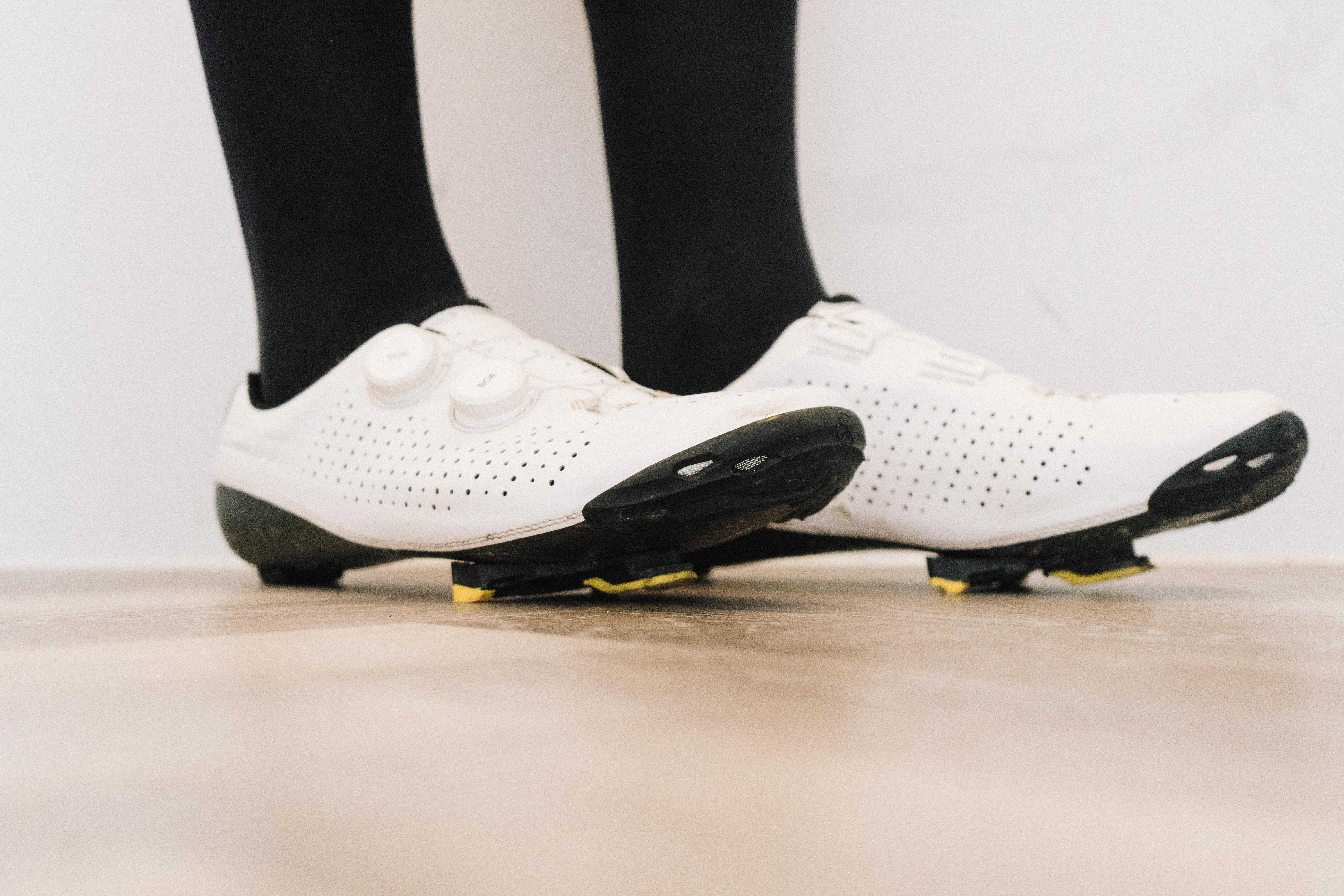
Specifications
Reasons to buy
Reasons to avoid
✅ You want a comfortable fit: Wide range of sizes, two width options and at-home moulding make the Vaypor's some of the most comfortable cycling shoes we have used.
✅ You want low weight: Bont Vaypors are incredibly light, only a gram or two heavier than the Nimbl's.
❌ You want a proper locked-in feel: The fit is rock solid, but they don't offer the truly locked-in feel of stouter cycling shoes
If comfort is your top priority, the Bont Vaypor is a shoe that should be at the top of your list due to its multiple sizing options and unique DIY custom moulding feature. Not only is it supremely comfortable, but the Vaypors back it up with performance too.
To start with Bont offers the Vaypor in 19 sizes (36-50) along with standard and wide widths, giving improved foot suitability across different shapes and types. While some cycling shoes have traditionally had a narrow shape, Bont has developed its anatomical shaping based on 20,000-foot scans, giving the Vaypor's a wider midfoot and toe box to give plenty of room for the foot to comfortably splay out.
If the fresh-from-the-box fit isn't quite perfect, Bont has another trick to further boost comfort. The Vaypor's can be custom moulded at home for a tailored fit to your feet. It's a simple process by heating them in the oven to 70 degrees, allowing small adjustments to be made for an even more refined fit.
When Will Jones reviewed the Bont Vaypor's, he found the non-stretch Japanese Durolite upper and two BOA Li2 dials retention gave a close and secure fit, spreading the pressure over the foot to avoid any hot spots.
Bont backs up this comfort with performance too. The low stack and ultra-stiff bath-tub style carbon sole gives a direct pedalling platform to ensure no watt is lost. The Vaypor are also extremely light, at 202g (EU42), they are very close to matching the lightest shoes on this list, the Nimble Feat Ultimate.
You can read more details in our full Bont Vaypor review.
Best wide fit cycling shoe
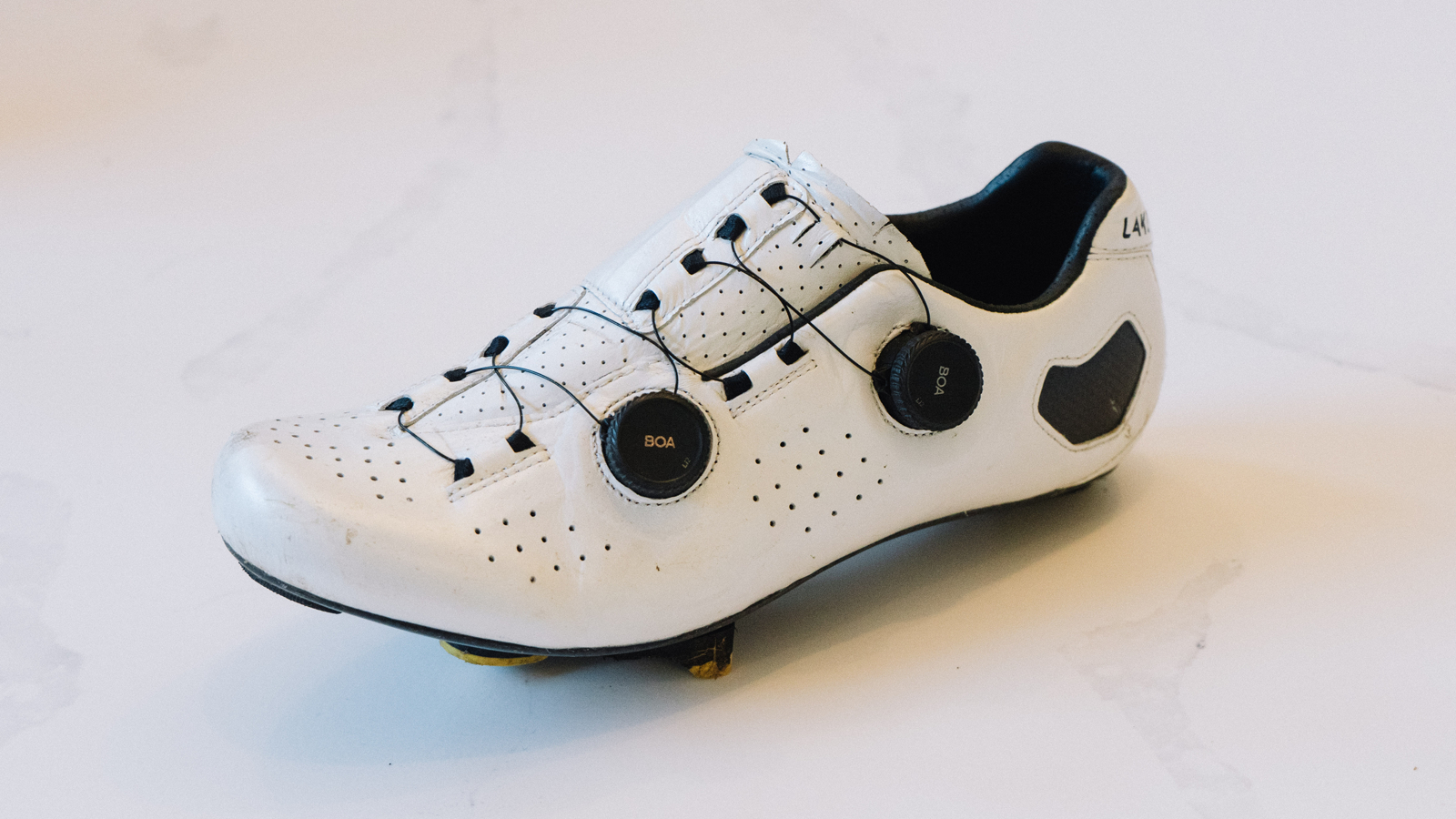
6. Lake CX333
Specifications
Reasons to buy
Reasons to avoid
✅ You have never found a shoe wide enough: Lake offers three different widths, with the regular size fitting wider than most cycling shoes.
✅ You want custom fitting: Like the Bont's, Lake also features at-home custom moulding to get a perfect fit.
❌ You want a light shoe: The CX333 are one of the heaviest shoes on this list.
❌ You want a rearward cleat position: In testing, Will struggled to get the cleats far back enough for his preferred fit.
We have a buyer's guide written by our resident wide-footed tester Will Jones, specifically covering the best cycling shoes for wide feet, listing the brands that cater for those who need a broader fit. Will's top pick, and the go-to for many bike fitters, is the Lake CX333 road shoe.
Lake offers narrow, regular and wide widths, although even though the CX333 uses Lake narrower CX Race last, the regular width is wider than most other performance shoes on the market. Although the CX Race last is wide in the midfoot, it narrows in the toe box so if you need properly large volume shoes, you will be better served by a Lake shoe that uses its CX/TX Sport.
Not only is there a load of sizing options, but you even have the choice of either Klite Kangaroo leather or Clarino Microfiber upper with Outlast temperature-regulating lining. Lake uses a Carbitex panel to aid arch support and, like the Bont's, the CX333 are heat moldable using an internal Thermaform Carbon Fiber heel counter to fine-tune the fit if needed. The stiff carbon sole has moulded vents for cooling, and the cleat can be vertically adjusted using a variety of markings, although Will would ideally like a little more rearward bias for the cleat position.
Also consider: Cycling shoes that just missed the cut
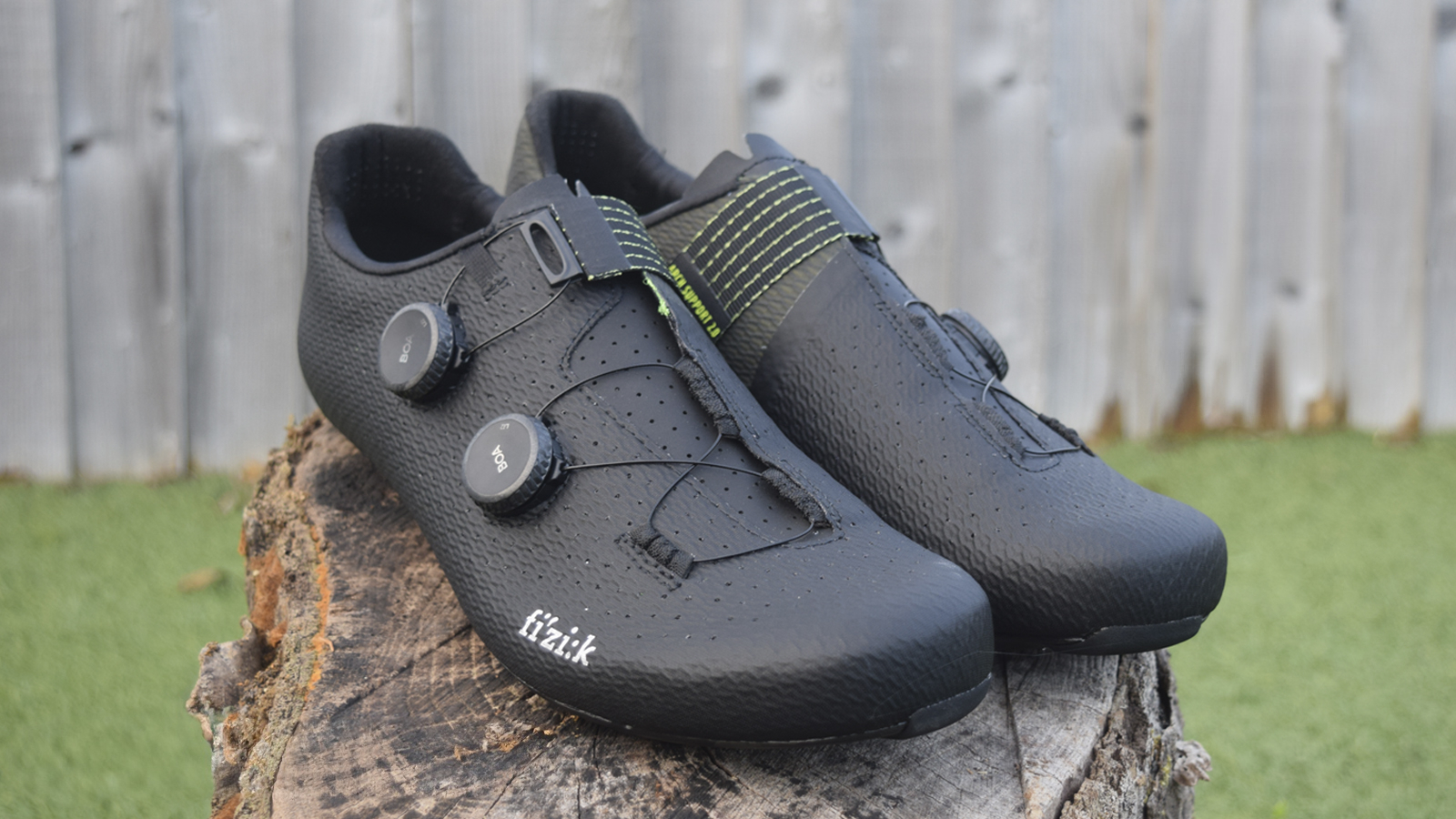
Specifications
Reasons to buy
Reasons to avoid
✅ You want good arch support: The design moulds to the shape of your foot's arch.
✅ You position your cleats further back: Fizik has moved the bolt holes rearward, so you should be able to position your cleats.
❌ You want good heel support: We found the heel cup to be loose.
❌ You want wet weather capability: The mesh section under the arch means you need overshoes to keep water out.
The Fizik Vento Stabilita Carbon is a shoe that does one thing better than anyone else. The design leaves the upper completely soft under the arch and then pulls the strap for closure through that same section.
Despite all the strengths, the strap that runs across the top of the foot can sometimes create a pressure point. The heel cup doesn't offer the support of alternatives either. It's a shoe that solves a very specific problem while potentially creating another.
For more details, read our Fizik Vento Stabilita Carbon shoe review.

Specifications
Reasons to buy
Reasons to avoid
✅ You want the Adidas stripes: The branding and style stand out.
✅ You want an all-rounder shoe: These shoes are a good choice for more casual riding.
❌ You want a stiffer sole: The nylon sole is too flexy for performance cycling.
❌ You want to buy without trying first: The sizing is a little small and we had to size up.
Adidas aims to offer a comfortable and stylish shoe for a specific segment of cyclists. The Road Cycling Shoes are comfortable for rides up to around three hours. You can feel the flexibility of the sole, but with shorter rides, it's not an issue. It becomes more noticeable when climbing, but keeping it mellow makes it not an issue.
The base being flexible nylon also means you can walk more easily, and at least with the neon green base, it doesn't show scratches like carbon.
Read more in our Adidas The Road Cycling Shoes review.

Specifications
Reasons to buy
Reasons to avoid
✅ You want stylish looks: We loved the clean uppers and all-white colour.
✅ You want a comfortable fit: We didn't experience any hot spots when riding.
❌ You have wider feet: The last is quite narrow.
❌ You want to be able to tighten down hard: We didn't find the dials positioned optimally for a tighter fit.
Although the Quoc M3 Air was good enough to step onto a podium when worn by Geraint Thomas at the Giro, it didn't quite make the cut for our guide. Quoc has kept it simple with the M3 Air, offering a comfortable fit and a great aesthetic, but the adjustment doesn't allow you to really ratchet the uppers tight. Expect plenty of cleaning of the white-only uppers too.
We've got a full review of the Quoc M3 Air if you're looking for more details.
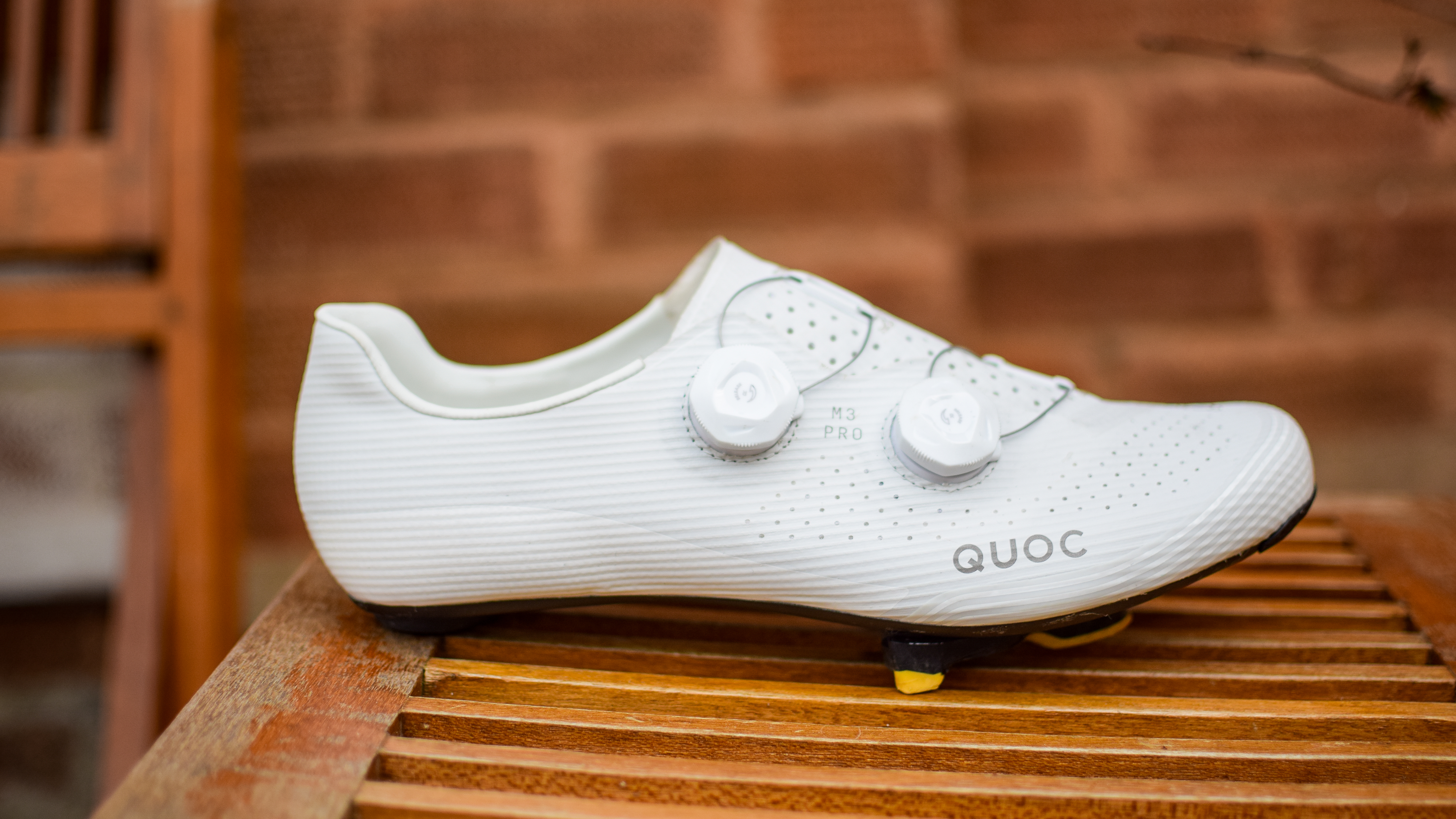
Specifications
Reasons to buy
Reasons to avoid
✅ You want Quoc's looks with easier cleaning: The gloss surface is easier to keep clean than the M3 Airs.
✅ You want good foot comfort: We've had no issues with Quoc's shoe comfort.
❌ You want any colour other than white: This is another top-end Quoc shoe that comes in white only.
❌ You live somewhere hot: The M3 Air may be a better choice for its added ventilation.
Quoc prices the M3 Pro the same as the M3 Air, but has made them a bit more serviceable, with the absence of mesh panels and a gloss rather than matte finish.
There's adjustable arch support via stick-on shims and we reckon the toe box is a little wider than the M3 Air's and the uppers more flexible. Quoc's dial closures aren't quite the match of a top-end Boa dial though.
The Quoc narrowish fit is carried over and, as with the M3 Air, there's just one colour available - white. That's great for dry summer rides, but it's harder to keep clean once things get at all wet or dirty, although the Pros do scrub up more easily than the Airs.
Read our full Quoc M3 Pro review for more.

Specifications
Reasons to buy
Reasons to avoid
✅ You want a great sole: Q36.5's sole is very stiff and the wrap-around heel provides good support.
✅ You want a slightly wider fit: The Unique Pro shoes have a more modern fit.
❌ You want to save money: The Unique Pros are right at the top end of cycling shoe prices.
❌ You want a shoe bag: We'd have liked to see one at this price, to keep the shoes pristine.
Among the most expensive non-bespoke cycling shoes available, the Q36.5 Unique Pro shoes boast a low 4.4mm sole stack height, with a super-stiff carbon sole that partially encloses the heel. The last is fairly straight, rather than curved, and has a wider forefoot box for comfort, with a quality Solestar insole.
We've found the Unique Pro shoes very comfortable, thanks to the forefoot volume, cushioning and the shape of the last. There's plenty of cooling airflow, even for long, hot rides, and the shoes clean up well.
The shoes are very expensive though and, while Q36.5 includes a shoe horn, we'd have liked a shoe bag more.
You can read more in our full Q36.5 Unique Pro shoe review. We've also reviewed the (non-Pro) Q36.5 Unique if you want something a little less wallet-busting.
How to choose the best cycling shoes for you
Here are our recommendations for what to consider when choosing cycling shoes:
- Budget: Cycling shoes can be frighteningly expensive, so it's a good idea to work out what you want to spend first.
- Pedal and cleat type: If you're just looking at road cycling, a three-bolt cleat interface is probably best; for off-road use, commuting or if you expect to walk in your shoes much, consider a two-bolt design.
- Stiffness: Largely dictated by shoe price, a carbon sole will be stiffer and more efficient than a nylon one.
- Type of closure: Dial closures allow you to fine-tune your fit and are, in general, more durable than velcro. Lace-up shoes are usually lighter but lack in-ride adjustability.
- Upper material: Many cycling shoes are made of synthetic TPU or faux suede, with ventilation holes or mesh sections to keep your feet cooler. Knitted uppers are an alternative that can offer greater airflow and comfort, but will get wet more easily and won't keep your feet as warm.
- Colour: Lighter colours may look nice, but they'll usually be harder to keep clean.
- Fit: Your cycling shoes need to be close, without being constrictive. We'd recommend trying before you buy, as there's a wide range of fit and sizing isn't always consistent between brands. Many shoes are available in half sizes. Wide fit shoes (see below) may work for you.
Everything you need to know about the best cycling shoes
What sole drilling do I need?
The first thing to consider is cleats. For road cycling shoes, that generally means a three-bolt cleat mounting system. These shoes are also ideal for indoor cycling and are compatible with the Look Delta cleats used by the Peloton Bike. We have a separate guide to the best indoor cycling shoes if you want more options.
If you prefer a two-bolt cleat, you'll need a shoe designed for that system and compatible with gravel bike pedals – so you'll want to have a look at our list of the best gravel bike shoes.
Why do road bike shoes use three-bolt cleats?
Road bike cleats are larger than those in other cycling disciplines and require more bolts to secure them tightly to the sole. The bigger cleat, combined with the larger surface area afforded by one of the best road bike pedals, provides a better platform for pedalling, leading to improved power production and efficiency.
Sure, you can use a two-bolt shoe that is easier to walk in, but this system is not without its foibles in a road-specific setting. While there are plenty of mountain bike or gravel shoes available, they are designed for off-road riding and resisting rock strikes, mud, and gravel – this means they are also heavier and will need specific pedals, too, which are also notably heavier than the best road bike pedals.
What about four-bolt cleats and compatible shoes?
Not all road cycling cleats attach to road cycling shoes with three bolts. There are also four-bolt Wahoo Speedplay cleats that work with Speedplay pedals, but it's a relatively uncommon option. It only applies to one type of pedal, while three-bolt systems encompass a variety of different cleats and pedals.
Speedplay cleats can also be mounted to shoes that use a three-bolt system with the use of the adapter included with the pedals, although this will increase the pedal stack height by a few millimetres.
Do lighter cycling shoes make a difference?
There is something liberating about not feeling the weight of your shoe as you move, and the numbers can be significant – some shoes differ by as much as 100-200g when comparing each end of the spectrum. As with everything related to cycling, though, lighter tends to be more expensive. For a light shoe to remain stiff, a better, carbon-fibre sole is required, and keeping the upper light necessitates the use of more costly materials.
What types of cycling shoe closure are there?
There are several different ways in which a cycling shoe's upper can be fastened.
Many top-end shoes use Boa dials, usually two but sometimes one. There are alternative dial closures, such as those used by Sidi and Quoc. High-end dial closures allow both lightening and loosening in small increments; lower-priced options will tighten in steps but need to be fully disengaged, then retightened, if you want to loosen them.
Velcro straps are another option. They're most common on lower-priced shoes, but also found in the forefoot of some dial-closed shoes and some ultra-light premium shoes, as well as triathlon shoes.
Ratchet closures have gone out of fashion, but you'll still find them on some budget shoes. You don't get the fine adjustment of dials and, as with cheaper dials, you need to release them to loosen the fit.
Finally, there are lace-up shoes. It's another option that keeps weight down in some premium shoes, as well as being found in some lower-priced shoes. The main issue with laces is a lack of adjustability while riding, although that doesn't seem to have held Tadej Pogačar back.
What are cycling shoe soles made of?
Top-end road cycling shoes invariably have carbon fibre soles. They offer stiffness for foot support and pedalling efficiency, as well as a thin sole for a low stack height and increased pedalling efficiency.
Lower-priced shoes may have nylon soles, sometimes reinforced with carbon fibre or fibreglass. This is cheaper to produce, but doesn't, in general, offer as stiff a sole and will add thickness.
Shoe brands will usually rate their shoes' soles for stiffness on a scale that goes from 1 to 10, 12 or even 15. Essentially arbitrary, this doesn't allow you to compare sole stiffness across brands, but can give a clue about where a shoe's stiffness fits within a single brand's line-up.
Should cycling shoes be stiff?
The answer here depends on your needs. If you spend more time on a bike, and you are generally riding harder, you will want a stiffer shoe – a stiffer sole translates to better efficiency, less flex, and improved power transfer.
If you aren't pushing that hard or riding that far, a softer shoe will be more comfortable and a less expensive option, owing to the use of nylon or fibreglass composite soles and less technical uppers.
Are road cycling shoes always narrow?
In the past, cycling shoes tended to be narrow, with pointy toe boxes that squeezed your toes and often with a banana shape. This could lead to discomfort, particularly if your feet are wider.
The modern trend is to make the forefoot of cycling shoes significantly wider, with a more rounded toe box, so there's more room for your toes to spread. This can significantly reduce the risk of foot discomfort, particularly for riders who place their cleats further back on the sole, which is another modern trend. The heel needs to remain narrow though, so that your feet don't slip around when pedalling.
For riders with wider feet, there are wide fit options for some shoes; Shimano has wide fit options for most of its shoes and Fizik has a wide fit range too, for example. Other brands, such as Bont, use a wider last, while Lake makes its shoes in multiple widths to suit different foot shapes. Bont's shoes are also heat mouldable to help them conform to your foot shape.
If you can't find a comfortable off-the-shelf shoe, a custom shoe may be the answer. There are niche brands that specialise in bespoke cycling shoes, but Bont also provides a full custom shoe option.
Do good cycling shoes make a difference?
A good pair of cycling shoes will feature lighter materials and a stiffer sole. Sometimes, as in the case of Lake or Sidi, you will find that there's a trade-off and instead of saving weight, the shoes will include niceties such as padding, venting, and other technologies.
Another factor to consider when shopping for a good pair of cycling shoes is cost. The bottom line is that you have to spend the money to get a better product. Having better quality cycling shoes is essential for comfort and performance, allowing you to ride farther and harder. You'll have fewer issues with hot spots in your feet, and the power you put into your pedals will propel you forward without delay.
Like all products, however, buying one of the best cycling shoes doesn't mean it's going to be perfect from the get-go – you may need to shop around, try on different options, and use inner support orthotics to achieve the best fit.
How do I get better foot support?
Many cycling shoes come with quite low-budget insoles which don't support your foot well. Choose a more expensive shoe, and it will often have a higher quality insole with adjustable arch support. You can also swap out your insole for a better aftermarket insole or a custom insole.
Some insoles have greater structure, including a bump under the midfoot to help splay the bones and reduce the risk of foot discomfort. Specialized's shoes feature its Body Geometry range of features designed to increase foot comfort.
How we test
Testing is the backbone of the tech department at Cyclingnews and how we test is taken seriously, so read on to find out more.
As part of the review process, every cycling shoe is inspected and weighed by our testers before we start riding. Careful consideration is taken when setting up each shoe to determine how easy it is to dial in cleat position and how the shoe integrates with different pedal systems.
When reviewing cycling shoes, it's vital to spend as much time as possible with as many different products as we possibly can. For shoes, this involves covering a wide range of riding conditions to identify the strengths and weaknesses of each shoe. Test rides include short and intense sessions, as well as long rides in the 6-8 hour range. The terrain is essential, too, and we make sure to take the shoes and ride everything from bike paths to mountains to see how they respond.
We do a bit of everything in them, from climbing to intense indoor racing. Weather plays a role, too, and our testers ride in all weather to get an idea of how the shoes perform in a range of climates.
The latest race content, interviews, features, reviews and expert buying guides, direct to your inbox!
Graham has been part of the Cyclingnews team since January 2020. He has mountain biking at his core and can mostly be found bikepacking around Scotland or exploring the steep trails around the Tweed Valley. Not afraid of a challenge, Graham has gained a reputation for riding fixed gear bikes both too far and often in inappropriate places.

